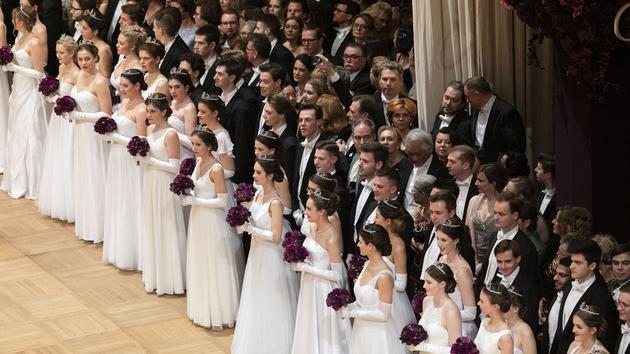Correct behavior more than required. Like linesmen in tennis, frowns and hands clasped behind their backs, protocol experts are placed along the red carpet. They stare at the approximately 5,150 guests of the Vienna State Opera Ball. Those who have allowed themselves some freedoms will be refused access to the Staatsoper, a jewel since 1877 of what some call the "Austrian Superbowl". Those who have passed the fire test will have to make their way through a crowd of people dressed to the nines.
»READ ALSO - Manuel Legris goes from the head of the Vienna Opera Ballet to that of La Scala
Old acquaintances greet each other as the cameras rotate and the flashes crackle. The ceremony is scrutinized by the Austrians, who will be millions watching it live on their television set. They will certainly recognize luminaries there - big bourgeois, business leaders or local stars - who flock to the grand staircase decked out in armfuls of flowers. Arrived well before the start of the show, all will wait in the cozy atmosphere of the salons and corridors, while keeping an eye on the watch. Because at the stroke of 10 p.m., 288 beginners will set foot on the opera floor, stripped for the occasion of its parterre of red velvet armchairs. A jury handpicked more than 5,000 candidates aged 17 to 24. The organizers pride themselves on being open to young people from all walks of life, the only prerequisite for applying is to know how to dance. In fact, to find its place in such a pageantry, it is still necessary to have a certain habitus ...
See this post on Instagram
A publication shared by Smaranda Luna (@sma_luna) on Feb. 21. 2020 at 4:43 PST
Outrageous extravagance
To be convinced, it suffices to observe the room, which is now full. In men, a white bow tie and a tailcoat are required. Some high-ranking officers pinned badges on it. In women, as long as the rules are respected, all daring is allowed. Lamé or glittery fabrics, guipure, frilly tulle, sequins ... This extravagance overbidding is reminiscent of an American prom. A fuchsia tutu overflows from the seat and tickles the nape of the neighbor in front. A lookalike of Timothée Chalamet rolls his eyes, weary of carrying his partner's long train. Hairpins strew the ground, sown by elegant women with complicated updos.
At 10 p.m. precisely, the Austrian anthem, sung in chorus by the audience, begins the festivities. Then, under the clamor and on the notes of the hymn to joy, the 144 couples of beginners make their entry in a seemingly endless stream. Their movements are performed with a string. In long white dresses, these young ladies hold in their gloved hands a bouquet of red flowers. As every year since the 1950s, their enchignées heads are surmounted by a Swarovski tiara, this time designed by Christian Lacroix. Their partners wear black suits and white ties. In rows of onions on either side of the oval hall, the 288 elected officials will remain stoic for a good part of the show.
In long white dresses, these young ladies hold in their gloved hands a bouquet of red flowers. Swarovski - Jürgen Hammerschmid
While an orchestra follows the waltzes of Strauss and the symphonies of Mozart, Puccini or Verdi, a troupe of dancers from the Vienna opera takes over the floor and delivers a graceful performance, generously applauded by the audience. The beginners' quarter of an hour can then begin. By shifting, by changing rank, they draw graphic tables, sometimes evoking a checkerboard, sometimes the skin of a zebra. This duotone matters to the organizers, who did not hide their relief this year, when a couple made up of two women - the first of the same sex to participate in the ball since its creation - proposed that one wears a suit of man. The abandonment of parity will not be at the expense of perfect symmetry.
See and be seen
Meanwhile, the audience dissipates. From the dressing rooms overlooking the room, the fine flower of the Viennese bourgeoisie is in the living room. Some talk, standing in the passageways. A couple in their sixties, long white beards for him and peacock feathers in their hair for them, get up and improvise a waltz under the amused gaze of their neighbors. In the middle of a symphony, the rattling of champagne glasses is heard. Laughter resounds. Despite some disapproving " shouts ", the informal aspect of the festivities seems to be accepted. Three women dressed in shades of red spot a known head in the box opposite. Seeing and being seen seems to be one of the vocations of the evening.
"Alles Walzer!" (“All on the track!”) Suddenly shouts a man. On this rallying cry, guests who were in ambush join the beginners to waltz. The small, orderly world of a few moments ago suddenly becomes a compact and variegated magma. The guests come and go. The evening gradually soaks up champagne. The cups pile up on the edge of the balconies. The opera has taken on the appearance of a nightclub whose faceted ball is the sumptuous crystal chandelier that adorns the ceiling. The party will continue until early morning. This old-fashioned ball alone embodies the permanence of a certain tradition. "Now what becomes of the Vienna waltzes?" " Worried François Feldman in 1989. He can reassure himself.

